|
The municipal territory of
Radda in Chianti covers 80.5 square km on the hills around the
deep valleys of the rivers Pesa and Arbia. It was a feudal centre and then
the residence of a mediaeval podesta from the 13 C onwards. It
was confirmed in its present day boundaries with the Leopoldine reforms of 1774.
Radda was recorded for the first time with certainty in an edict of the
Emperor Otto III from 1003 when its Court and castle were
owned by the Florentine Abbey to whom they had been donated by the Marquis di Toscana, to whom it was confirmed by the Imperial
authority. This was repeated several times in the following decade either
by an act of succession by Otto or by a series of Papal endorsements.
Radda became a feudal possession of the Guidi Counts in 1220, by command
Federico II. Towards the middle of the 13 C (the precise date is not known),
Florence affirmed its dominion
here because of Radda's strategic importance. From 1176, Florence had jurisdiction over the greater part of
southern Chianti previously belonging to
Sienna.
Firenze put Radda at the head of one of the three "Thirds" in which the Chianti League was administratively divided, and starting from 1384
at the latest, it became capital of the Chianti League, as is shown by the oldest
preserved statutes. In the middle of the 1300s, on the orders of the Florentine government, the wall of the castle were
reinforced, and new fortifications were needed after the Aragonese invasion in
1478 during which the Radda castle was conquered and devastated. Other periods of
warfare had to be lived through in the first half of the 1500s, until the fall of the
Siennese republic. From then on Radda was principally an active agricultural
centre.
More
about the history of Radda.
Storia
di Radda in italiano.
|

